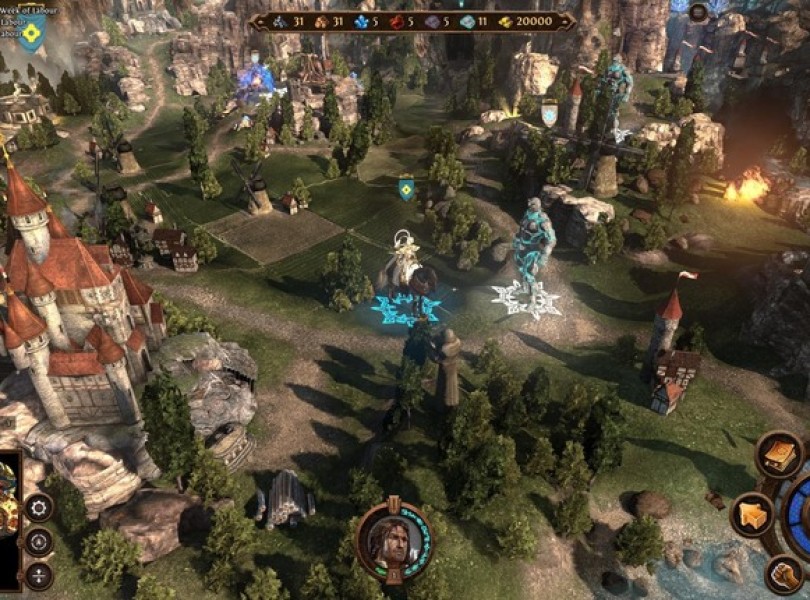Casting the same old spell.
By Leif Johnson
It’s not hard to draw parallels between Might and Magic Heroes 7’s protagonist, Ivan Griffin, and its developer, Limbic Entertainment. Much like Griffin, the studio has inherited a domain and wants to play it safe by not discarding traditions or ruining the most well-regarded features. The result is a strange roleplaying-strategy experience that’s at once nostalgically enjoyable and somehow unfulfilling. As promised, the spirit of the glory days of the Heroes of Might and Magic series reveals itself here, but it lacks both personality and polish even as the strategic elements provide decent challenges.
We want to hear it.
To its credit, MMH7 generally gets the broad strokes right. True to the series, this is a turn-based game about sending heroes out to explore a world shrouded in a fog of war, where they find resources, allies, and foes hidden throughout. Finding one of the latter means jumping into strategic battles that superficially resemble Holochess from Star Wars, and where your named heroes dish out damage and protect their minions for the sidelines. That’s all here, and there’s virtually nothing here that hasn’t been seen before aside from a welcome addition in the ability to deal additional damage to enemies by flanking them with multiple soldiers. Caravans also make a comeback in MMH7 (after a disappointing absence in MMH6), allowing the hire and placement of new units in town without the need for them to travel with the hero, keeping the pace of exploration steadily entertaining.
Dynamic events sometimes pop up on the overworld map, such as when an ogre smashes a key bridge in two with a boulder.
The few other additions to the old formula chiefly amount to eye candy, as in the dynamic events that sometimes pop up on the overworld map, such as when an ogre smashes a key bridge in two with a boulder. It’s a shame, then, that Limbic’s efforts at prettifying the world and characters sometimes backfire, as in the ways that the seven resources (like wood and ore) sometimes get lost in the busy details of the otherwise-attractive maps.
There’s also a drive for simplification at work here — one that’s aimed at bringing the series back to its roots and stripping away the chaff that’s worked its way in since the late ’90s. Gone, for instance, are the 3D towns; in their place, Limbic introduces 2D town maps where you can create and upgrade new troops and buildings through an intuitive progression tree. They’re drab at first, but rather impressive to behold once everything’s in place. MMH7 simplifies the business of hero progression as well, while still providing many options, chiefly through the introduction of a skill wheel that lets you put points in everything from Leadership for troop boosts to bonuses for actual combat attacks.
We want to hear it.
It all works well enough, save for several bugs, such as heroes vanishing into towns never to return.
It all works well enough, save for several bugs, such as heroes vanishing into towns never to return, or a camera that seems to have a mind of its own, and performance issues that sometimes seem to stem from running Ubisoft’s Uplay overlay at the same time as Steam’s, and sometimes are unrelated. By far the most annoying one was the way clicking on one part of the map would sometimes send my hero right where I wanted them to go, but for the next turn I’d have to click multiple times to get them to move.The biggest problem is that there’s a lot of nuance interwoven through the gameplay’s fabric that goes unexplained, such as stacking a bunch of weaker ranged troops together to make a formidable force or how turns are limited by abstract increments known as “days” and “weeks.” No tutorials introduce those ideas, and with no significant formal manual and much of the interface lacking tooltips, there’s a lot of potential to confuse rookies that could’ve easily been avoided.
MMH7 was clearly designed as a fan’s game, but in this regard Limbic pushes the concept to a fault. It’s almost as though there’s an assumption in play here that new players who’ve never tried the series wouldn’t be interested. At one point, in fact, I found myself looking up a wiki from a previous Heroes game to gain some insight into MMH7’s gameplay.
We want to hear it.
Again, I had plenty of fun with MMH7’s exploration and battles, but the presentation seems a step down from what I’ve come to expect from this series. Might and Magic Heroes VI gets a lot of flak these days, but at least its animations and combat sounds were fun to listen to. That isn’t always the case in MMH7, where some creatures slap each other like drunken brawlers and poor audio cues sometimes fail to reveal that something important has happened.
The 3D character models simply sit dead still around the table like lifeless mannequins.
This tendency carries over into the main story as well, which centers on Griffin and the leaders of the six factions chatting it up around a table as though this was the war room in Dragon Age: Inquisition. If only it were. The 3D character models simply sit dead still around the table like lifeless mannequins, and the camera shifts to each of them when it’s their turn to speak. Their mouths and bodies never move, and the whole effect reminds me of those creepy exhibits at museums where little lights appear over wax effigies of historical figures as they speak. If it’s meant to be artistic, it fails horribly, and it doesn’t help that the overarching plot is essentially about a guy who’s worried that he can’t do his job.
Still, the structure of flashing back to legends of heroic deeds as a framing device for each of the seven four-part campaigns is a smart concept in some respects for the actual gameplay, as it allows us to play all of the self-contained faction storylines without suffering through rehashed lore as a result of playing the same tale from different sides. (Be warned, though: there is no Inferno or dwarven faction here.) In one, you’ll trot over desert wastes with the orcs of the Stronghold; in other, you might ride unicorns through the leafy glades of an elven forest.


Advertisement
Advertisement
hand-drawn cutscenes used in these mini-campaigns fare much better than the 3D ones.
The variety involved was enough to keep me interested for the roughly 50-hour campaign, and while the ground troops sometimes share abilities among factions, the settings and model designs are usually enough to grant each faction its own personality. As a bonus, the hand-drawn cutscenes used in these mini-campaigns fare much better than the 3D ones, and while I found myself wishing they were properly animated, they worked well enough that I wondered why Limbic bothered using 3D models at all.
Concerns about the campaign aside, the other options hold a lot of promise for future gameplay: there’s online, hot seat, or LAN multiplayer maps for up to eight players, and a Duel mode that lets you skip all the resource-collecting in order to jump right into combat. (It’s too bad there are only eight skirmish maps, and as of the time of writing three days after launch, I couldn’t get a multiplayer game to connect at all.) It also comes with a feature-rich map editor, which allows you to mold terrain and make factions of your own. Provided MMH7 gains enough momentum with its community, someday there could be a wealth of fan-made content to draw on – but that’s impossible to guarantee.
There’s very little that’s new about Might and Magic Heroes 7, and that’s a good thing when it comes to its classic-style tactical roleplaying exploration and combat and menus that make managing resources easy to understand and let heroes explore at a rewarding pace without frequent backtracking. It manages to scratch a very old PC gaming itch, at least between the awful cutscenes and performance problems.



